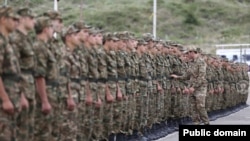The figure is set in Armenia’s draft state budget approved by the government on Thursday. It is equivalent to 6 percent of anticipated GDP. Overall public spending is projected to reach nearly 3.5 trillion drams ($8.9 billion) in 2025.
Speaking at a cabinet meeting in Yerevan, Finance Minister Vahe Hovannisian said the planned rise in defense spending is needed to boost “the country’s resilience to possible risks” to its national security.
As always, the government did not publicize a breakdown of expenditures that will be made by the Armenian Defense Ministry. It is therefore not clear which part of the projected defense budget will be spent on arms acquisitions.
Commenting on a steady increase of that budget in recent years, Armenian officials have pointed to Azerbaijan’s military buildup which has continued even after the 2020 war in Nagorno-Karabakh.
Azerbaijani President Ilham Aliyev on Thursday reaffirmed his pledges to expand and strengthen his country’s armed forces. Aliyev again threatened Armenia with military action earlier this week. His government plans to spend over $3.9 billion on defense and national security next year.
Despite this spending gap, Baku regularly complains about new weapons purchased by Yerevan. Earlier this month, Aliyev’s top foreign policy aid called for “restrictions” to be placed on the size of the Armenian army and its arsenal.
Russia had for decades been the main source of weapons and other military equipment supplied to Armenia. But due to a deepening rift with its traditional ally, the South Caucasus country has significantly diversified the sources of its arms acquisitions in the last two years. India and France now seem to be its leading arms suppliers.




